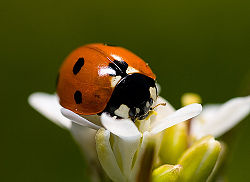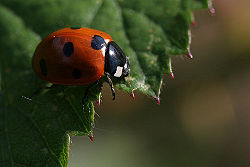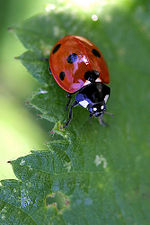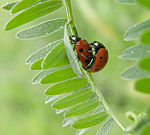Seven-spotted ladybug
| Seven-spotted ladybug |
|---|

|
| Scientific Classification |
|
| Binomial Name |
|
Coccinella septempunctata |
| Image Description |
A ladybug can also be called ladybird, ladybeetle or Coccinellidae. The word, Coccinellidae, means "clothed in scarlet". There are approximately 5000 species. Most ladybugs eat plant-eating insects like aphids which are their favorite food, so they help farming. They are the most valuable beetle to human. Their wings fly 85 times a second while flying. The ladybug is the state insect of Tennessee, Ohio, New Hampshire, Delaware and Massachusetts. [1] The seven-spotted ladybug is one of the most common ladybugs. It is also called Coccinellidae septempunctata. It is called that, because it has seven black spots on the two wings in the back. Other than the slight different appearance, most of the ladybugs have the same anatomy, reproduction, life cycle and ecology.
Anatomy
All ladybugs have pretty similar external structures, but internal structures and mouthparts are a little different and up to their own food they eat. A seven-spotted ladybug is a mid-sized ladybug with seven black spots on two wings. An adult one is about 7 to 8 mm, a larva can grow up to 7 or 8 mm, and an egg is about 1 mm. The larva has a grey blue skin. The adult has two hemispheric hard wings called elytra and soft wings for flying underneath elytra. The wings' color can be changed into red, black, pink, or orange to protect itself from predators. The seven-spotted ladybug also has six legs for locomotion like all insects. There is a claw which helps grip better at the end of each leg. It has two antennae for touching and smelling and a jaw to eat food. A pronotum, which helps protect the head, is behind the head. [2]. In the male, there is a notch on sternites and flexor bonds between sternites. It also have setae, hair-like structures, on segments. However, the female does not have any of those except a little of setae. [3]
Reproduction
Each species of ladybug has its own pheromones for attracting. They reproduce sexually. The male holds in the back, and they stay put for two hours. The female can keep the male's sperm for two or three months. The female can lay more than 1000 eggs in the lifetime. The ladybug goes through a complete metamorphosis, having egg-larva-pupa-adult stages just like all beetles. The female lays small eggs, and once the larva gets out of the egg, it has six legs. The skin of the larva starts splitting and showing a pupa. The size of the pupa is as big as an adult. The stage from egg to adult takes about three to four weeks. [4]
Ecology
Seven-spotted ladybugs live in trees, shrubs, fields, homes and places where there are plants. [5] The length of seven-spotted ladybugs depend on the environment around them like temperature, humidity and food. There are eight ways of seven-spotted ladybugs' feeding, feeding on mildews, mites, whiteflies, cottonycushion scale, mealybugs, armored scale insect, scale insects and aphids. [6] Seven-spotted ladybugs are known as predators of aphids. Larvae eat approximately 400 aphids during the stage to a pupa. An adult eats about 300 aphids before laying eggs. It can eat 100 aphids in one day. Approximately, one adult eats 5,000 aphids during its lifetime. A seven-spotted ladybug has alkaloid toxins, adaline, coccinelline, exochomine, hippodamine and so on. Those smells are disgusting and make their blood unpleasant. That is one of ways to keep predators away from itself. [7]. A seven-spotted ladybug overwinters after being an adult. It saves fat in fall and eats the fat during the winter.
Positive and negative ways of using ladybugs
In a positive way, there are some uses of ladybugs in a biological control. The ladybugs are mobile and appetitive, so humans use them to regulate the population of the pests without using chemicals. One of the ways of using them is called manipulative biological control. The second is augumentative control. The last one is classical or inoculative control. For the manipulative and augumentative control, the ladybugs are already present in place, but the numbers of them are not enough to regulate the aphids. For the classical control, the ladybugs are not in place and there are no enemies for aphids. In a negative way, seven-spotted ladybugs have been brought to North America for regulation of pests. However, the problem is the foreign ladybugs fight and take away places of the native ladybugs. This would affect diversity of ladybugs and ecology. [8]
Gallery
References
- Seven-spotted ladybug [9]
- Coccinella septempunctata [10] Scott Robinson, Beckman Institute for Advanced Science and Technology.
- Seven-spotted ladybug [11] J. Howard Frank and Russell F. Mizell, University of Florida, 2000-2006.







